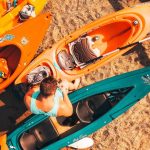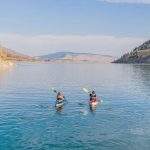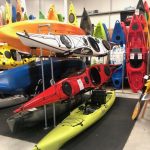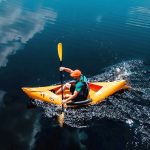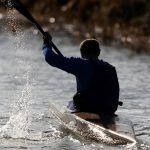In this article, we’ve got all the information you need to decide on the optimal kayak size. Discuss kayak sizes like a pro!
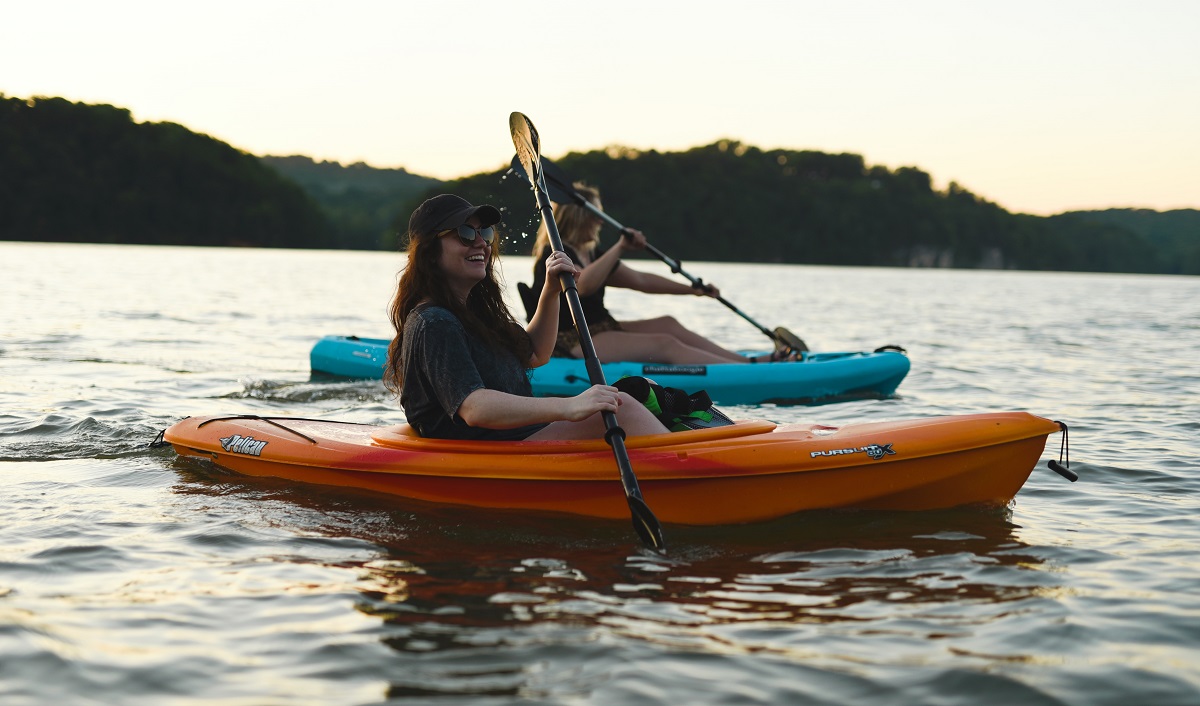
When should you choose an 8 ft kayak over a full-sized kayak? Is going with a smaller kayak going to cost you in terms of stability or handling? Is an 8′ kayak worth the money? What is the best 8 foot kayak on the market right now?
We’re going to answer these questions—and a whole lot more—in the article below.
As an affiliate of Amazon and other retailers, we may earn a small commission when you buy via our links, at no additional cost to you. Thank you!
Quick Answer: The Best 8-Foot Kayaks
Best for Adults: Lifetime Daylite 80
Most Durable: Lifetime Lotus 80
Best for Junior Paddlers: Pelican Clipper 80X
Best Ultra-Compact: Advanced Elements Firefly
Best Budget-Friendly Inflatable Kayak: Sevylor Quikpak K1
Best Whitewater: Dagger Rewind MD
Most Agile: LiquidLogic Homeslice
Comparison Table: Best 8-Foot Kayaks
| Model | Specs | Where To Buy |
Lifetime Daylite 80 | Weight Capacity: 250 lbs. (113 kg) Weight: 36.5 lbs. (16.5 kg) Design: Sit-on-top | Amazon |
 Lifetime Lotus 80 | Weight Capacity: 250 lbs. (113 kg) Weight: 36.5 lbs. (16.5 kg) Design: Sit-on-top | Amazon |
 Pelican Clipper 80X | Weight Capacity: 200 lbs. (90.7 kg) Weight: 27 lbs. (12.2 kg) Design: Sit-inside recreational | Pelican Sport |
 Advanced Elements Firefly | Weight Capacity: 250 lbs. (113 kg) Weight: 16 lbs. (7.3 kg) Design: Inflatable sit-inside | Amazon |
 Sevylor Quikpak K1 | Weight Capacity: 400 lbs. (181.5 kg) Weight: 20.2 lbs. (9.2 kg) Design: Inflatable sit-on-top recreational | Amazon |
Dagger Rewind MD | Weight Capacity: 220 lbs. (99.8 kg) Weight: 43 lbs. (19.5 kg) Design: Whitewater | Dagger |
 LiquidLogic Homeslice | Weight Capacity: 220 lbs. (99.8 kg) Weight: 32 lbs. (14.5 kg) Design: Whitewater | LiquidLogic Kayaks |
The Best 8-Foot Kayaks Reviewed
Best 8-foot Recreational Kayak for Adults: Lifetime Daylite 80

Weight Capacity: 250 lbs. (113 kg)
Weight: 36.5 lbs. (16.5 kg)
Design: Sit-on-top
Material: High-Density Polyethylene (HDPE)
If you’re looking for a simple recreational kayak that you can use anywhere, anytime, this Lifetime model is definitely a pick worth considering. Though it’s shorter than average, the open cockpit and sit-on-top design makes it suitable for even full-grown paddlers to spend a great day out on the water. The multiple footrest positions allow you to place your legs and feet how they feel most comfortable, and the molded seat with adjustable backrest offers better-than-average comfort and support.
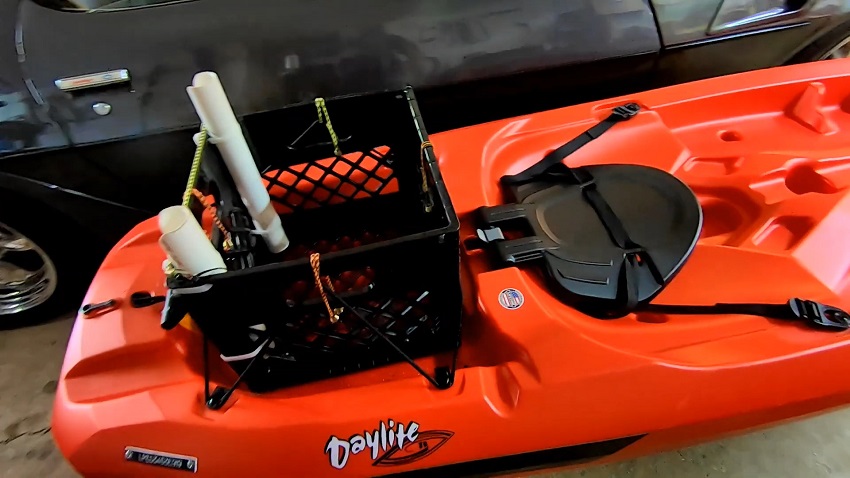
The kayak is beautifully tough, made from high-density polyethylene that has integrated UV protection to keep it from wearing out or deteriorating even with regular exposure to sunlight. Though it’s a recreational kayak, you can use it for fishing, with tankwell storage sized for a cooler or tacklebox and bungee cord storage to keep everything securely lashed down. When you reach your destination, just slide the paddle into its recessed holder so you can hold your fishing rod with both hands.
The scupper holes ensure the water will always drain out, keeping your cockpit as dry as possible even when the wind and spray are up. Thanks to the integrated handles—both the front-and-rear handles and the center carry handle built into the hull—you’ll always have an easy time hauling it around. Tough, comfortable, affordable, and backed by a 5-year warranty—what’s not to love?
Most Durable: Lifetime Lotus 80
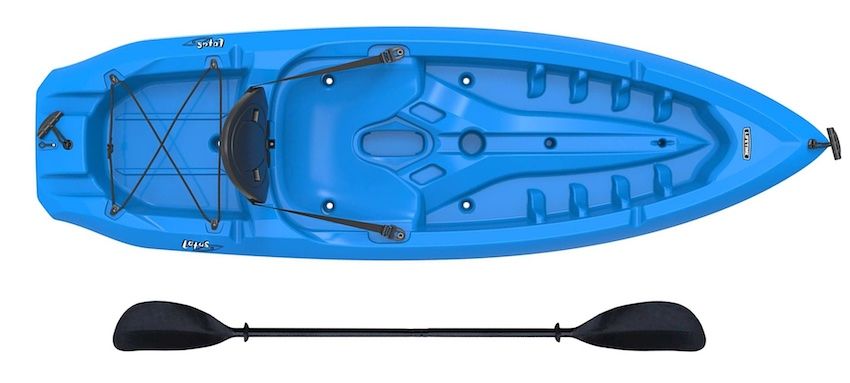
Weight Capacity: 250 lbs. (113 kg)
Weight: 36.5 lbs. (16.5 kg)
Design: Sit-on-top
Material: High-Density Polyethylene (HDPE)
If you want a kayak that can survive anything, you’ll love the Lifetime Lotus 80. It’s built using extremely tough High-Density Polyethylene (HDPE) that is capable of withstanding impacts, abrasions, scuffs, scrapes, and the sort of rough handling that you’d expect from beginner and young kayakers. Really, it’s as close to “bomb-proof” as a kayak will get, and the open cockpit sit-on-top design means you’ll never have to worry about bailing it out or struggle to right it if/when it capsizes.
Despite being a simple recreational kayak, it’s stable enough your young and small paddlers can use it for fishing, nearly impossible to roll over on flat water. Run it down a slow-moving river, and you’ll have a full day of comfort thanks to the multi-position footrests, molded seat, and adjustable backrest. It could use a bit more lumbar support (for those of us with back problems), but for the average teenager or youth, it’s more than supportive enough.
Other great features include: molded paddle cradle, self-bailing scupper holes, tankwell storage, integrated bungee cord to keep everything securely in place, and integrated front, rear, and center carry handles. It’s not so heavy your child or teenager will struggle to carry it to and from the water, but the hull is thick and sturdy enough that it will give you years of consistent use without ever breaking or breaking down.
Best for Junior Paddlers: Pelican Clipper 80X
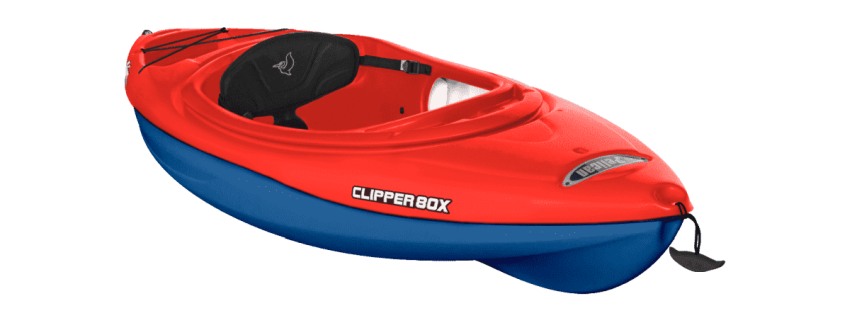
Weight Capacity: 200 lbs. (90.7 kg)
Weight: 27 lbs. (12.2 kg)
Design: Sit-inside recreational
Material: High molecular weight polyethylene
Go ultra-budget-friendly with Pelican’s best 8-foot kayak, the Clipper 80X. You’ll find few other hard-shell kayaks with a price tag to match, and even some of the best 8-foot inflatables will cost as much. However, just because it’s affordable, that doesn’t mean it sacrifices durability, versatility, or comfort.
The sit-in design and compatibility with both Pelican and universal spray skirts will keep you dry even when the wind is up. At under 8 feet long (7’ 9”), it’s short enough even small children can handle it with ease, and its high primary stability is perfect for young beginner paddlers who are just getting their paddles wet for the first time. Add to that a twin-arched multi-chine hull, and you’ve got a kayak that makes steering and tracking much easier than any other on our list.
It’s a recreational kayak first and foremost, so it may not be well-suited to choppy waters or stable enough for stand-up fishing. However, despite its compact size, it’s incredibly buoyant and will keep even weaker swimmers safe out on the lake or floating downriver. Though it’s built using high molecular weight polyethylene, it’s one of the lightest kayaks on our list (just 27 lbs.) so even young kids can portage it with ease. It’s built for junior paddles—stable, tough, and comfortable, everything they need to get out on the water in style.
Best Ultra-Compact: Advanced Elements Firefly
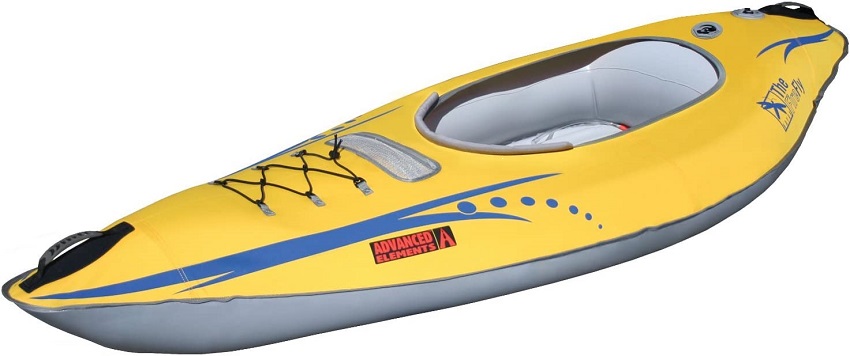
Weight Capacity: 250 lbs. (113 kg)
Weight: 16 lbs. (7.3 kg)
Design: Inflatable sit-inside
Material: 600 D polyester cover and PVC Tarpaulin hull
Looking for a kayak that can handle any conditions? You’ll definitely want to give the Advanced Elements Firefly a try! This bad boy isn’t just built for flatwater; it can also handle slow-moving rivers (Class I and Class I), bays, inlets, and even calm ocean conditions. It strikes a wonderful balance between primary and secondary stability, keeping you from tipping over no matter where you’re paddling.
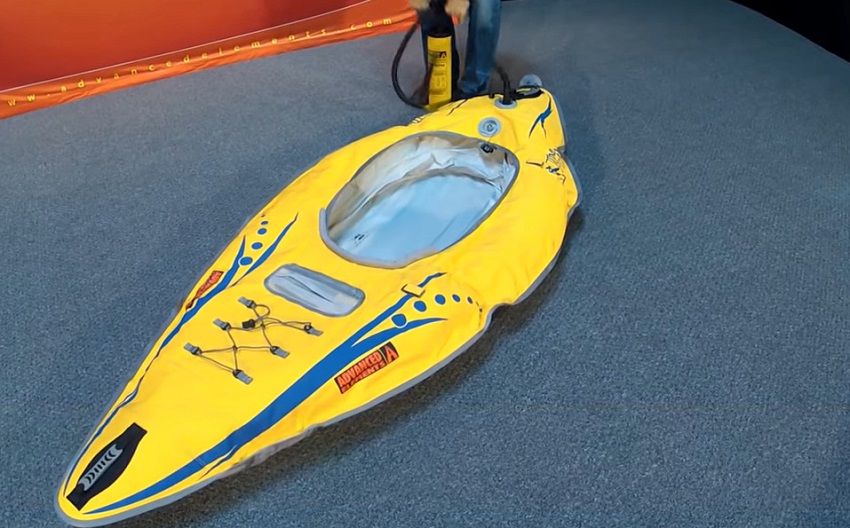
The fact that it’s an inflatable kayak means it folds up beautifully small; fit in the trunk of your car, the back seat, the bed of your truck, or even in your RV so you can take it with you everywhere you go. At the end of the season, it’ll be compact enough not to take up unnecessary space in your garage, but it’s ready to deploy when the weather warms up.
Thanks to the built-in rigid panels, the stern and bow are clearly defined and, together with the integrated tracking fin and landing plate, give you much better tracking and handling than a pure inflatable. The Twistlok and high-flow Spring valves make inflating and deflating a much faster-than-average process, and you’ll find that in any state, the 600-denier polyester cover and PVC tarpaulin hull are beautifully durable. Best of all, at 16 pounds, it’s lightweight enough even young children can carry it around.
Best Budget-Friendly Inflatable: Sevylor Quikpak K1
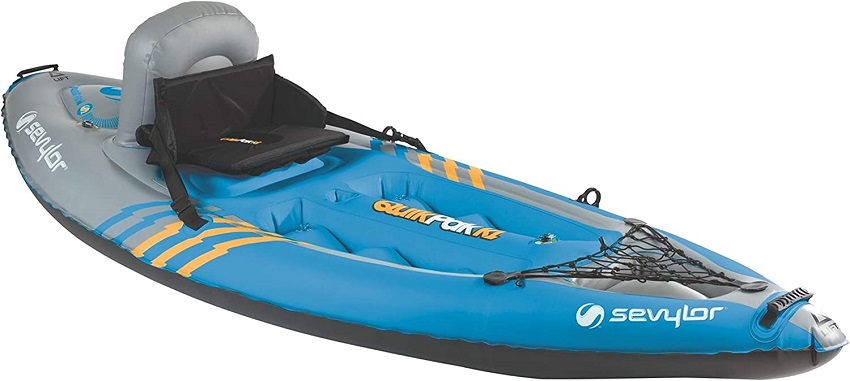
Weight Capacity: 400 lbs. (181.5 kg)
Weight: 20.2 lbs. (9.2 kg)
Design: Inflatable sit-on-top recreational
Material: 21-gauge PVC construction
If you want to keep it cheap because, let’s face it, kids aren’t great at being gentle with their toys, this inflatable kayak is the perfect 8-footer to get your children out on the water today. At a fraction of the price of the higher-end models on this list, it’s a budget-friendly choice that anyone can afford.
But don’t think affordable means “cheap”; the kayak is built tough in its own right, using 21-gauge PVC in its construction. The hull is sturdy enough that it won’t pop or sustain damage if your kids crash into the dock, each other, rocks, or underwater obstacles. But even if does get damaged, the multiple chambers ensure that only some of the kayak will deflate—meaning you’ll still be able to paddle back to shore safely. And thanks to its high buoyancy and excellent primary stability, the open-cockpit sit-on-top kayak will be a great choice for even newbie paddlers who aren’t yet totally steady out on the water.
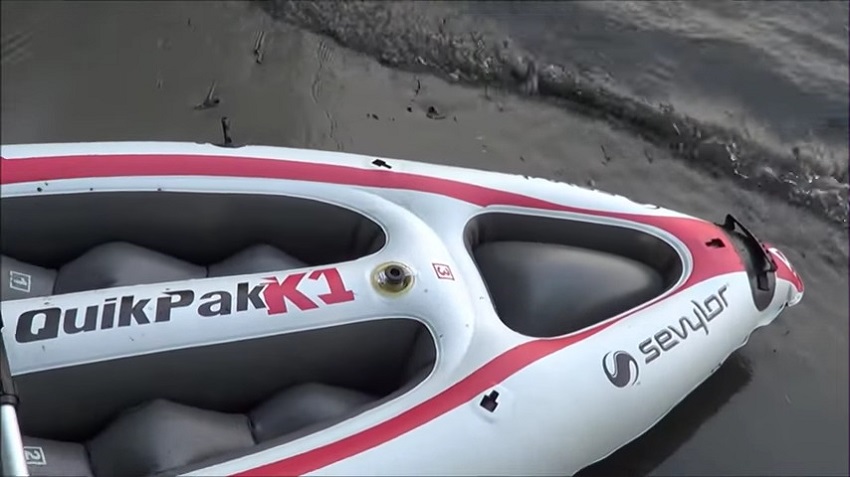
Like all inflatables, the kayak rolls up beautifully small and fits into the backpack. At just over 20 pounds, it’s nice and light, easily transportable along with the rest of your camping, fishing, and paddling gear. It comes with its own paddle, as well as a fast-inflating pump that makes setup and break-down a much quicker process. For your comfort, the seat comes with bottom cushioning and both an inflatable and strap-tightened backrest to give you decent lumbar support.
Best Whitewater: Dagger Rewind MD

Weight Capacity: 220 lbs. (99.8 kg)
Weight: 43 lbs. (19.5 kg)
Design: Whitewater
Material: Rotomolded polyethylene
If you’re headed out to paddle some whitewater rapids, you’ll definitely want to ride this kayak downriver! Rated for Class I to Class V rivers, it’s capable of handling anything you throw at it with style, and it’s among the toughest, longest-lasting whitewater kayaks on the market.
The kayak is suited for paddlers of all skill levels, great for beginners taking their first easy runs and experts tackling the hardest rapids in the country. Thanks to its ample bow volume and high rocker, it’ll keep you paddling at full speed even after steep drops and bring you racing back to the surface if you ever get submerged. The low-volume stern ensures that you can make those sharp hairpin turns on a dime, navigating even the tightest waterways with ease.
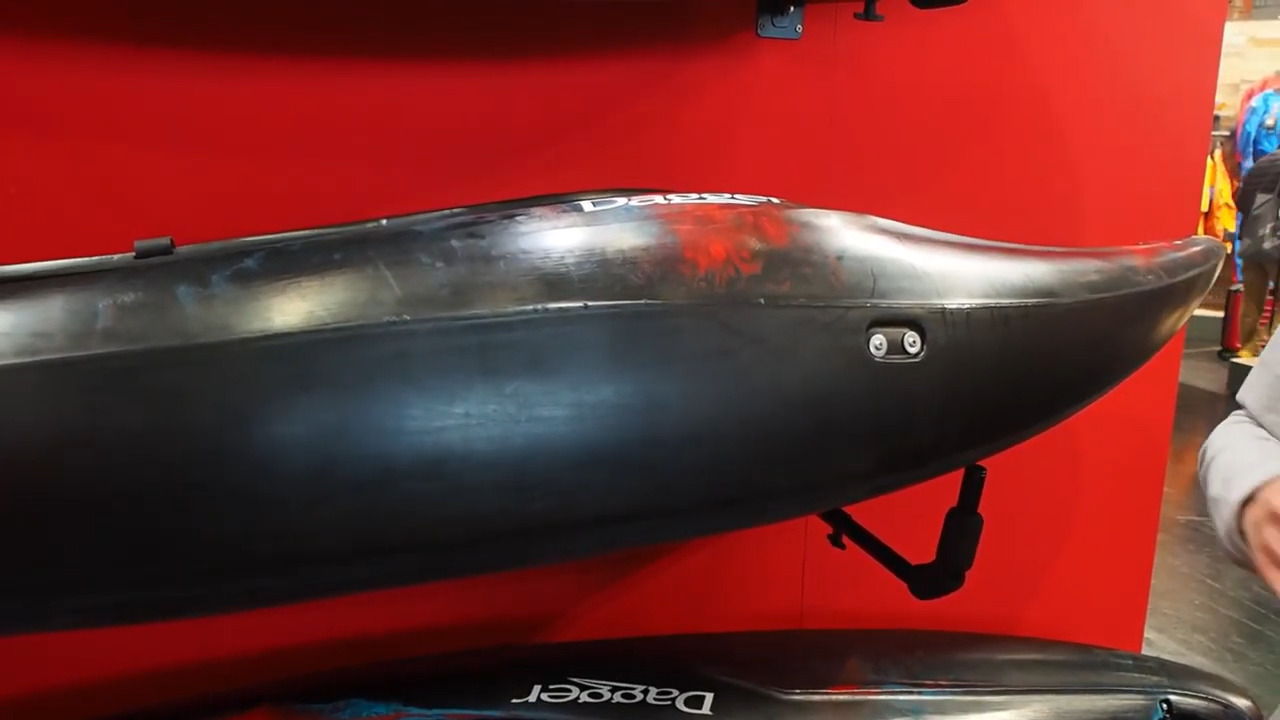
For your comfort, the kayak is equipped with a rotomolded seat and Contour Ergo backrest, ratcheting backband adjustments and leg lifters, thigh braces, foot braces, and both a step-out wall and security grab handles. Weighing in at 43 pounds, it’s the ideal boat to race downriver at full speed through even the most treacherous rapids.
Most Agile: LiquidLogic Homeslice

Weight Capacity: 220 lbs. (99.8 kg)
Weight: 32 lbs. (14.5 kg)
Design: Whitewater
Material: Rotomolded plastic
You’ve never met a kayak quite as agile or maneuverable as LiquidLogics’ Homeslice! This kayak has a unique low-volume design that can slice through even the fiercest rapids, offering precision handling and a beautifully zippy ride.
The kayak’s unique squareness gives you total control over your steering, carving through waves while still keeping you loose and agile enough to spin on a dime. The progressive rocker and V-shaped hull offer great secondary stability that makes it easy to stay afloat and upright even in huge swells. You’ll cartwheel, splat, surf, and squirt like a boss in this compact little 8-footer.
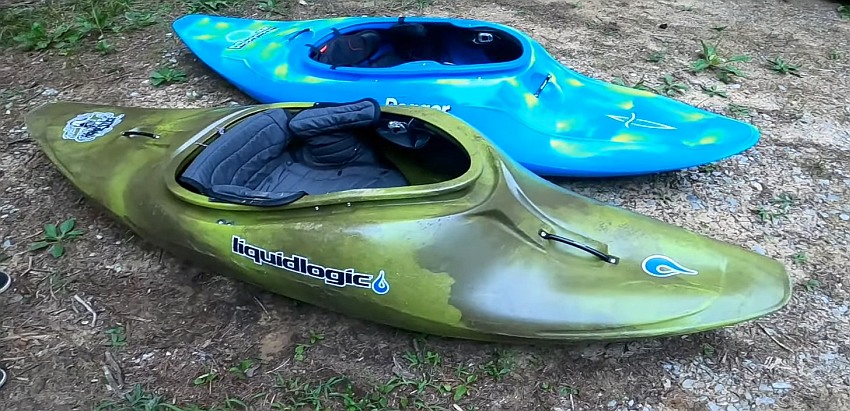
Despite its compact size, it’s surprisingly roomy on the inside, with a cockpit sized for taller users with plenty of space for longer legs. Though its weight capacity isn’t best-in-class, it is beautifully lightweight (at 32 lbs.), making transport to and from the water a breeze. It’s also insanely tough and able to withstand the sort of beating you can expect while whitewater kayaking. For the price, you won’t find many better or more maneuverable options around!
Your Complete Guide to 8-Foot Kayaks
When you shop around for kayaks, you’ll find out pretty quickly what the “standard” size is for most kayaks.
- Around 10 feet for recreational kayaks
- Around 11 feet for fishing kayaks
- Around 12-14 feet for touring kayaks
Funny how they seem to get longer, right?
So if these are the “standard” sizes, it looks like an 8-foot kayak is a “small” option.
Below, we’re going to look at why this small option may be the best choice for you. We’ll compare the pros and cons of an 8-footer to those of a “full” or “standard-sized” kayak. I think you’ll quickly see there are some excellent instances when you’re better off going small.
Why Choose an 8-Foot Kayak
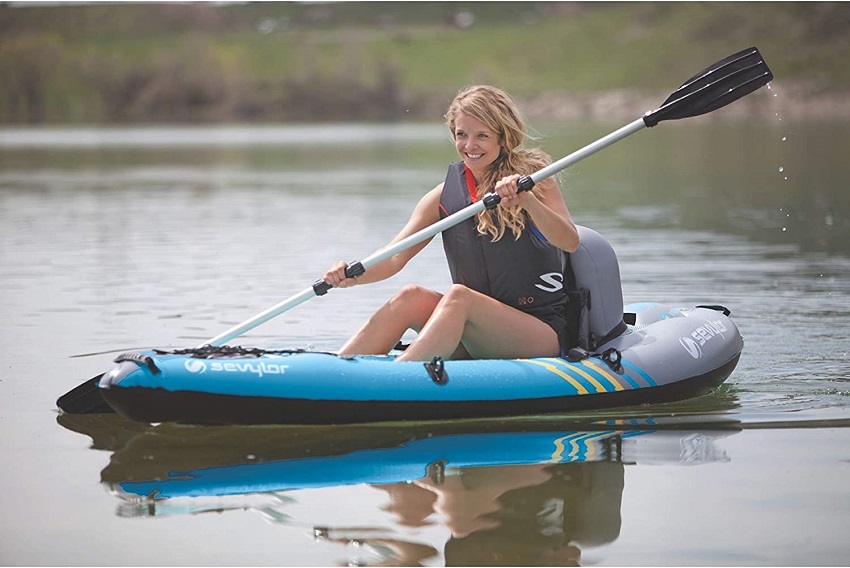
There are three reasons to choose an 8-foot kayak over the “standard” sizes:
For kids or teenagers
Children don’t need a full-sized kayak. Truth be told, smaller kids probably can’t even handle a full-sized kayak.
Full-sized kayaks tend to be heavy and take more effort to maneuver. For kids or teenagers who are just getting into the paddling life and don’t have a lot of experience kayaking, a smaller kayak ends up being easier for recreational paddling.
But even if they’re experienced paddlers, a smaller kayak is typically the smarter choice for young children. They can grow into a full-sized kayak, but putting them in an 8-footer ensures they can keep pace with you.
For smaller adults
As a very tall man (6’6”) myself, I’ve always got to shop on the larger side of everything—and yes, that includes kayaks. No surprise, I’m paddling a 12-footer capable of carrying a man of my leg length and body weight.
But for my 5’3” wife, it’s a very different story. There’s just no way she can efficiently paddle my large kayak, so she prefers her 10-footer. Or, on those rare occasions when a friend loans us their 8-ft, lightweight kayak, she definitely prefers the smaller kayak.
For anyone under 5’, it may be a good idea to consider an 8-foot kayak. There’s plenty of legroom for shorter adults, but the smaller size and lesser weight make paddling around a whole lot easier.
For whitewater kayaking
While a lot of 8-foot kayaks are designed for kids and very small adults, the really good ones are built for whitewater kayaking.
When whitewater kayaking, you’ve got to make a lot of really sharp, fast turns to avoid collisions and navigate tight spaces. If you tried it in a full-sized kayak, you’d be at a huge disadvantage to a speedy, compact 8-footer.
Whitewater kayaks tend to have a shorter length but a higher rocker (the hull rises up toward the stern and bow sprits with a steep curve) for a few reasons:
- It enables more agile handling and maneuvering
- It allows you to float over big waves rather than pierce through them
- It makes it easier to fit into small pools of calm water (eddies) so you can “eddy out” when ending or pausing your downstream runs
When on flat water, whitewater kayaks tend to be difficult to handle—really, you’re not going to go anywhere fast, because these kayaks are built for agility rather than speed. Keep that in mind when shopping for an 8-footer!
Pros and Cons of 8 Ft Kayaks
Pros:
- Great for smaller adults, kids, and teenagers
- Suitable for newbies just learning to paddle
- Whitewater kayaks designed specifically for challenging rapids
- Much more maneuverable than full-length kayaks
- Lighter and easier to transport, load, and unload
- Good stability (with the right width-to-length ratio)
- Often cheaper than full-length kayaks
Cons:
- Not the speediest; you won’t cover a lot of distance fast
- Not very roomy, and very uncomfortable for taller paddlers
- May not be very stable (when built sleek with a low width-to-length ratio)
Shopping for an 8 ft Kayak: Factors to Consider
By now, you’ve probably got a pretty clear idea whether an 8-foot kayak is something that suits your needs. You might be planning a whitewater kayaking trip and need a kayak capable of handling the challenge, or you’re wanting to take your young kid, teenager, or very short spouse out on the water with you.
If an 8-footer is what you’re looking for, I strongly recommend you take the time to read over this Buying Guide to learn what factors are most important to consider when kayak shopping.
Design
Kayaks are specifically designed with intended use in mind.
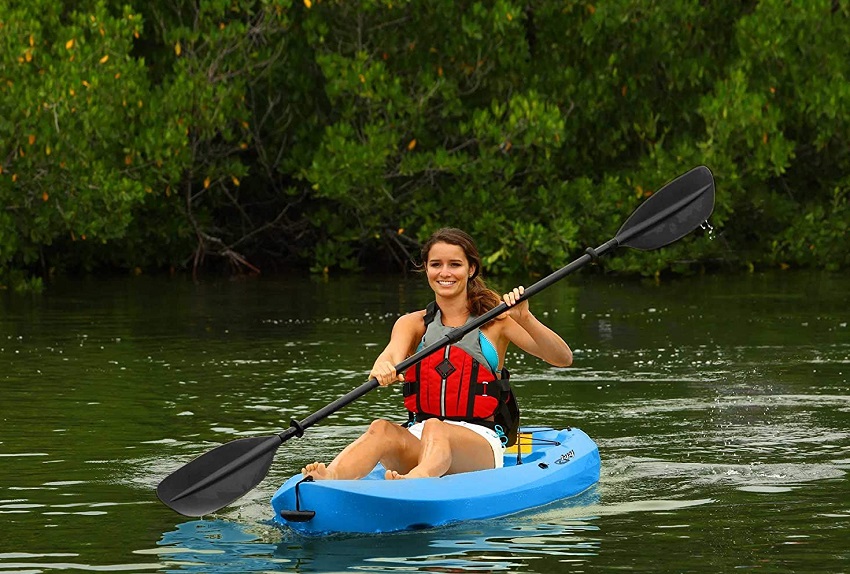
For example:
- Recreational kayaks designed for flatwater purposes will have higher primary stability, and may be either a sit-inside or sit-on-top design.
- Fishing kayaks always have higher primary stability and will usually be a sit-on-top design with an open cockpit that allows more room for you to move around when fishing.
- Ocean kayaks are longer, sleeker, and speedier, with an enclosed cockpit (sit-inside) that will keep the water out even if you’re slicing through waves or tackling rough ocean currents.
- Whitewater kayaks are short (usually in the 8-foot range) and heavier because of the incredibly sturdy, extra-thick materials used in their construction. The sit-inside design offers protection against impact.
Think about what type of kayaking you plan to do/have access to in your area, and find the right design for that specific activity.
Weight Capacity
When it comes to kayaks, there’s typically a pretty simple rule of thumb: the heavier you are, the longer your kayak will need to be.
I learned that the hard way the first time I tried kayaking in my wife’s 10-footer. The weight capacity of the kayak was just too low to accommodate my weight, so I ended up taking on water and capsizing because I rode too low in the water.
She, however, can paddle an entire day without taking on more than a few drops because her weight is well below her kayak’s maximum load capacity.
You might be thinking, “Well, based on your rule of thumb, doesn’t that mean most 8-footers will have a fairly low weight capacity?” And you’d be right!
As you saw above, I recommended an 8-footer be used by either a child, teenager, or small adult—not only because it was easier to handle, but also due to their limited weight capacity.
Important Note: Whitewater kayaks are the exception to this rule. Many 8-foot whitewater kayaks are made with an “average” or even “above-average” weight capacity because they need to support the weight of heavier paddlers without being oversized or compromising agility and maneuverability.
Keep in mind when considering the kayak’s weight capacity that you’ve got to factor in both paddler weight and the weight of any accessories (PFD, paddles, bailing kit, etc.) and gear (coolers, dry bags, food, water, etc.) that you’re carrying.
Comfort/Fit
Comfort and fit are two separate factors, but they tend to go hand-in-hand.
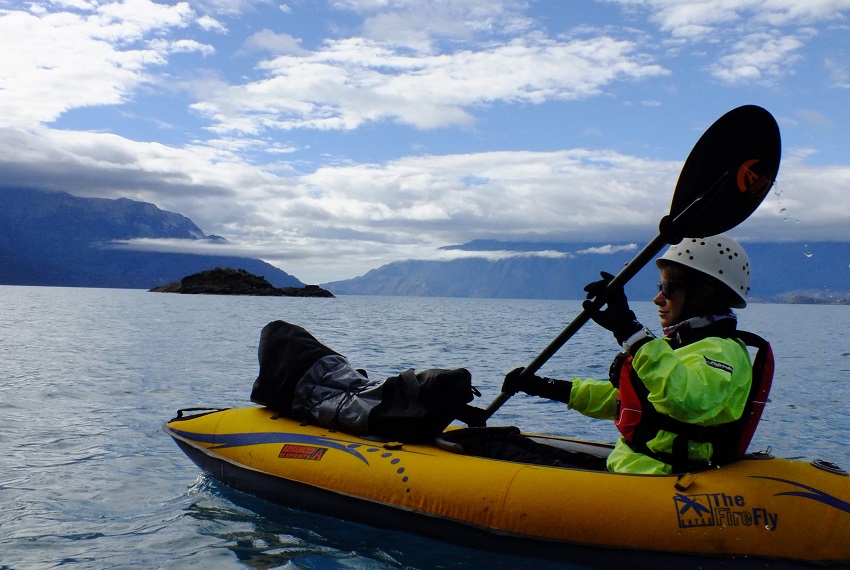
With fit, it’s all about the space inside the kayak, whether you’ve got enough room to fit your legs in the proper position to paddle correctly.
Or, for a sit-on-top kayak, whether the kayak is long enough to handle the length of your legs, or if your feet/toes end up dangling off the front end when paddling (which, let me tell you, gets quite uncomfortable after an hour of two!).
Comfort takes it a step farther, factoring in not only the fit, but also other features like the seat design (molded into the kayak body or an external cushioned seat), back support, knee and thigh braces, even the foot rests.
It should go without saying that a kayak should be the right fit for the paddler who will be using it, and offer enough comfort to make it a ride the paddler will enjoy for long hours.
Stability
When we talk about “stability”, there are really two types of stability to consider:
1) Primary stability, or the steadiness of the boat when on flat water.
2) Secondary stability, or the steadiness of the boat on choppy water that causes it to tip onto its side.
For primary stability, typically a high width-to-length ratio is crucial. A wide, flatter-bottomed boat will be very stable on flat water, maybe even stable enough that you can stand up. This is why fishing kayaks and paddleboards usually feature this design.
For secondary stability, though, things get a bit more complex. Things like V-shaped hulls, chines, and high rockers all contribute to better secondary stability, enabling you to tackle tall ocean waves or whitewater swells without capsizing or overturning.
Flatwater kayaks (including fishing and recreational) will emphasize primary stability, while whitewater and ocean-going kayaks tend to emphasize secondary stability.
Materials
I could spend hours doing a deep dive into the many advanced and fascinating materials used in the construction of kayaks. But don’t worry, in this article, I’ll keep it brief!
Typically, 8-foot kayaks are built using polyethylene, a heavy but incredibly durable plastic. Like all hard-shell kayaks, they’re created using one of two methods:
- Thermoforming, or applying a heated, pliable sheet of plastic over a mold and left to harden into that shape.
- Rotomolding, or pouring liquid plastic into a mold, then rotating it to disperse the materials around the walls of the mold.
Many 8-foot kayaks, especially whitewater kayaks, are made using the rotomolding process, because rotomolding creates a hull that is basically indestructible. The plastic is very impact-resistant, capable of withstanding the myriad bangs, bumps, and collisions that are part and parcel of whitewater kayaking.
And, because rotomolding ends up costing less than thermoforming, it’s typically used to build the more “budget-friendly” 8-foot kayaks used for kids, especially because many higher-end thermoformed kayaks are made using the pricier ABS plastic vs. the cheaper polyethylene plastic used for rotomolded kayaks.
Rotomolded kayaks do tend to be heavier, though, so if you’re looking for something lighter and more portable, it may be a good idea to shop around for kayaks (especially recreational and fishing kayaks) built using the thermoforming process.
Speed/Maneuverability/Tracking
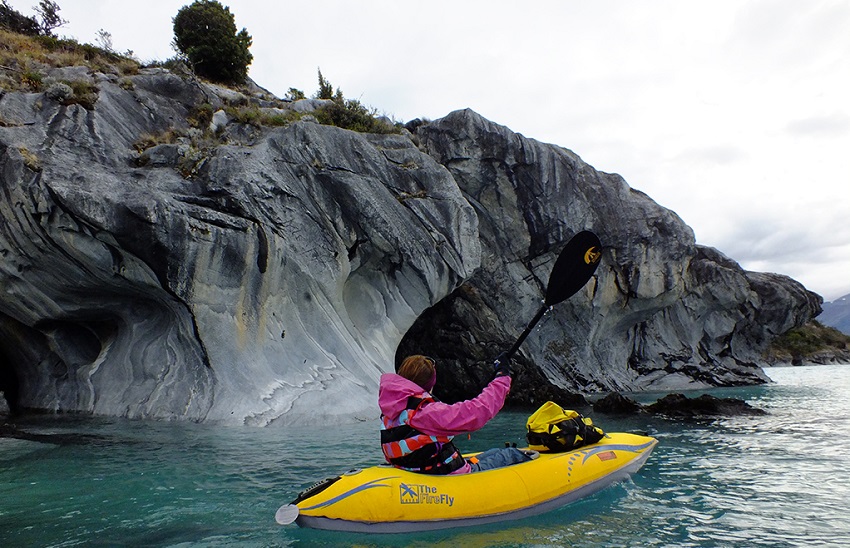
When it comes to speed and agility, you won’t find better than 8-foot kayaks. Because they are so short, there is less kayak ahead of and behind you to create friction and drag in the water, so they turn faster.
8-foot kayaks, especially whitewater kayaks, are designed to “spin on a dime”. When racing at high speeds down rapids, you’ve got to be able to make some split-second maneuvers to avoid collisions or to catch the water at just the right angle of attack.
Even 8-foot recreational and fishing kayaks tend to be more agile than their 10 or 12-foot counterparts. If maneuverability is high on your list of priorities, a shorter kayak may be the way to go.
However, be aware that by opting for higher agility, you’re losing speed. Longer, sleeker kayaks will always be faster than shorter, broader kayaks. If you’re trying to cross vast expanses of flatwater—such as traveling up a slow-moving river or navigating a lake—the 8-footer will always move slower than a longer kayak.
Tracking is another factor to keep in mind. Certain design features—like a longer hull or the presence of a rudder or skeg—improve tracking, or the ability of your kayak to “stay on track” and move in as straight a line as possible. Shorter kayaks tend to zig-zag more, because they’re built for agility rather than straight tracking.
It’s definitely not a deal-breaker; it’s just something to be aware of when shopping for an 8-footer.
Durability
You’ll be glad to know that most 8-foot kayaks are incredibly durable—and it’s largely thanks to the material used.
Remember how I said that rotomolded kayaks were basically indestructible? The polyethylene plastic is insanely tough, capable of withstanding impacts even at high speed. That’s why most whitewater kayaks are built using that specific material and with the rotomolding process.
Compare that to longer, sleeker kayaks—like the fiberglass or Kevlar sea touring kayaks—that are built to be light and speedy, but are less impact-resistant. You won’t find many kayaks more durable than an 8-footer—and yes, that goes for fishing and recreational kayaks (also typically rotomolded polyethylene) as well as whitewater kayaks.
Weight
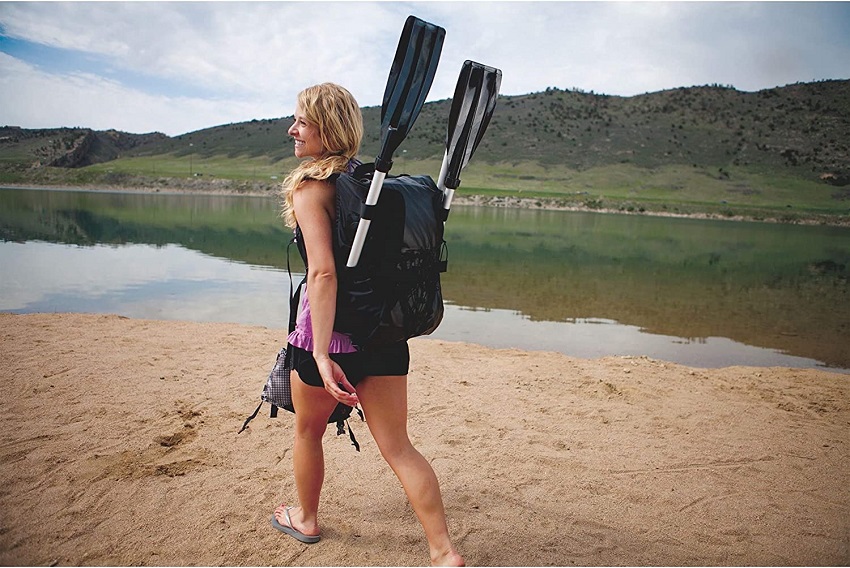
Weight is an important factor to consider when kayak-shopping, but especially when you’re shopping for an 8-footer.
If you’re whitewater kayaking, you want the kayak to be as sturdy as possible, so you won’t mind a bit of extra heft if it adds durability to the kayak.
But for the “average” person shopping for an 8-footer, chances are the paddler intended to use it will be a child, teenager, or small adult. These paddlers may not have the muscle strength to carry an extra-heavy kayak to and from the water—hence, you’re shopping for a lighter, shorter kayak!
Thankfully, 8-footers are significantly lighter than their longer counterparts, usually in the 15 to 30-pound range. They’re amazingly portable, and designed that even young kids are capable of carrying them.
Storage Capacity
Storage capacity is a big deal if you’re going to be spending long hours or multiple days out on the water. Chances are, with an 8-footer, you’re either zipping down a series of rapids or your kid/teenager/smaller-sized spouse will be paddling around a lake for a few hours. Really, not much storage needed!
Still, you want at least some storage capacity—somewhere to stash your dry bag, a bottle of water, some backup gear, or in the case of a fishing kayak, your cooler/s.
Most sit-inside kayaks will have a small storage compartment or two (some watertight, some not). Sit-on-top kayaks will usually have storage wells designed to fit a cooler or tackle box.
Bear in mind, though, that with an 8-footer, you’re sacrificing at least 2 feet of length. That means there is less space on board the kayak to use for storage.
Features and Accessories
When shopping for an 8-footer, it’s worth considering whether the kayak comes with any useful extra features or handy accessories, such as:
- A comfortable adjustable seat with good cushioning and lumbar support
- A rudder system or skegs
- Rails or tracks to attach fishing rod holders and other accessories
- A mount for a trolling motor
- Paddle keeper
8-foot kayaks tend to be fairly “barebones”, without much in the way of accessories. Still, it can’t hurt to look just in case!
Price
Last, but certainly not least, it’s worth considering just how much the kayak will cost you.
8-foot recreational and fishing kayaks tend to be a bit cheaper than their 10+ foot counterparts, because they’re usually stripped down, barebones, and designed with fewer fluffs and frills. There are a lot of “budget” models that make a great choice for kids, teens, and smaller adults new to kayaking—some as cheap as $200!
Whitewater kayaks, on the other hand, tend to be a bit on the pricier side. They’ll cost more than your average recreational or fishing kayak because, though they’re built small, they have to be extra tough and typically feature a more advanced hull design.
Expect to spend upwards of $500 for a low-end whitewater kayak, and as much as $2,000 to $3,000 for a top-of-the-line model.
8 Foot Kayak FAQs
Smaller, lighter adults can definitely use an 8-foot kayak. Anyone who is above 6’ tall will likely find that the cockpit of a sit-inside kayak is far too small to accommodate their legs, and an 8-foot fishing kayak will be short enough that their feet will likely hang over the edge. However, if you’re short enough to fit inside and light enough for the weight capacity, an 8-foot kayak will suit you, regardless of age.
Typically, quality whitewater kayaks will have an “average” weight capacity—between 150 and 250 lbs. Heavier whitewater paddlers may have to look for a 9- or 10-foot kayak if they need a higher weight capacity.
8-foot recreational kayaks will usually have a weight between 80 and 150 pounds, while some 8-foot fishing kayaks may be able to hold up to 175 pounds.
If you’re small enough to fit inside the cockpit/on the open deck of an 8-foot kayak, you’ll find that the increased agility makes it easy to maneuver the kayak. However, you won’t be able to push it quite as fast as you might like, which may make it difficult to keep up with fellow paddlers in longer, speedier kayaks. The reduced tracking offered by the shorter hull can also prove challenging. Adults who are serious about mastering paddling skills may want to consider a 10-footer for the improved speed and better tracking it offers.
However, for kids and teenagers who are just getting into kayaking, an 8-footer can be a lightweight, maneuverable, and beautifully beginner-friendly choice.
Whitewater kayaks are designed with higher secondary stability that keeps them from capsizing on the choppy, current-tossed waters of rapids. However, they can feel very tippy on flatwater, and will be more likely to flip over if you’re on very calm water.
By contrast, recreational and fishing kayaks are built with higher primary stability, meaning they’ll be incredibly stable and difficult to flip on flatwater. But if you take them down rapids or onto the ocean with lots of waves and swells, they are far more prone to capsizing.

